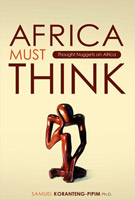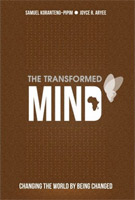Christian Dress & Adornment
CHRISTIAN DRESS & ADORNMENT
Why Try To Look Good, When You Can Easily Be Good-Looking?
By
© Samuel Koranteng-Pipim, PhD
Speaker: Excellence Bible Lecture Series
Introduction
We can generally tell the work a person does by how they dress (cf. doctors, UPS workers, nurses, prostitutes, schools people attend, etc.). We may even be able tell one’s religion by their clothing (Muslim, Sikhs, Nuns, Rastafarians, Amish, Adventists, etc.). More importantly, a person’s character is often revealed by their dress. Thus, the subject of dress and adornment should be of interest to Christians, since our outward appearance may say more about our faith than what we actually say.
The issue of dress and adornment should not only be of interest to women. It equally applies to men—especially in our changing times when men are beginning to dress and adorn themselves just as women.
Bodily adornment involves the use of jewelry (gold, silver, pearls, etc.), elaborate hair-dos, and expensive clothes to enhance beauty or attraction. In some cases bodily adornment also involves the enhancement, elongation, or diminution of certain parts of the body—lips, butts, eyes, etc. Because the standards of beauty (hence the use of adornment) differ from culture to culture, Christians must know how they are to beautify themselves.
Key Questions: Are there principles in the Bible to guide a Christian on how to dress? Does the Bible encourage the use of jewelry for bodily adornment?
Dictionary Definitions of Key Words:
Dress (verb) = 1. to put clothes on somebody; 2. to wear clothes of a particular type, or wear them in a particular way; 3. to put on clothes appropriate to a particular occasion, especially formal clothes
Dress (noun) = 1. the clothing required for a particular occasion; 2. the outward appearance or covering of a thing, especially a living thing, or the way in which something is presented.
Adorn (verb) = 1. to make more beautiful or attractive; 2. to add decoration or ornamentation to something; 3. to add to the beauty or glory of something or somebody
An Adornment (noun) is decorative item or material added to something to make it more beautiful or attractive
Ornament (noun) = 1. a thing used to adorn something, but usually having no practical purpose; 2. decoration added to embellish something
Jewelry (noun) = personal ornament, such as necklaces, rings, or bracelets, that are typically made from or contain jewels or precious metals
Dress and Jewelry
Principles from Garden of Eden
In the Garden of Eden God clothed man with the light of His glory or character. Clothing reflects the character. After the Fall (when the light of God’s glory vanished and Adam and Eve saw they were naked and when God dressed our first parents), no mention is made of ornamental jewelry as the appropriate form of clothing for fallen humanity. Instead, the Bible seems to point to the garments of God’s righteousness.
After sin entered the world, human beings have been trying to clothe themselves with their “fig leaves” to cover their nakedness. Observe that after sin, it was Adam—not God—who first brought up the issue of clothing:
God: “Adam, Where Are You?” (Gen 3:9)
Adam: “I heard your voice in the garden and I was afraid because I was Naked, and I hid myself” (Gen 3:10)
God: “Who told you that you were naked? Have you eaten from the tree which I commanded you not to eat?” (Gen 3:11)
Adam and Eve’s primary concern was their physical nakedness. But God’s primary concern was their spiritual condition. God was concerned that they had disobeyed His Word and that their relationship with Him had been broken. Whereas our first parents were concerned about their external appearance (their looks), God was concerned about their inside (their hearts).
Initially God didn’t even address the issue of their nakedness (looks). First, He dealt with them about the root issue of their hearts--the broken relationship; He gave them the Gospel (Gen 3:15)--the promise of the solution for their sin. Then, God came back to the matter of their clothes.
Again, observe that when God got to address the issue of nakedness (looks), God’s idea of clothing was different. Adam and Eve tailored fig leaves and made themselves “aprons” (Gen 3:7; KJV) or “loincloths” (ESV)--i.e., partial cover for their private parts. God sewed for them “garments” (Gen 3:21; KJV) or “tunics” or “coats”--i.e., total covering. Man’s idea about clothing is about pelvic concerns. God’s idea about clothing is complete/total covering.
God’s idea of complete/total covering (garment vrs. apron) points to the adornment of Christ’s righteousness--Christian character-- which we’re to put on. Christian clothing should be a reflection of Christ’s character--both inside and outside. Christians should “put off” their external aprons (outward looks) and “put on” the garments of righteousness.
Put Of/Put On Principle. It was from God’s clothing of our first parents in the Garden of Eden that we learn about the New Testament principle of “Put Off/Put On” of Christian dress and adornment. Let me explain:
Ephesians 4:22-24
22 That ye put off concerning the former conversation the old man, which is corrupt according to the deceitful lusts; 23 And be renewed in the spirit of your mind; 24 And that ye put on the new man, which after God is created in righteousness and true holiness.
Eph 4:28-5:4
PUT OFF PUT ON
Falsehood Truthfulness
Stealing Generosity
Unwholesome speech Edifying speech
Bitterness, rage, anger, kindness, compassion,
slander forgiveness
Obscene speech Thanksgiving
Romans 13:14
“Put on the Lord Jesus Christ, and make no provision for [put off] the flesh, to gratify its desires.”
Eph 4:22-24
“Put off . . . your former conduct, the old man which grows corrupt according to the deceitful lusts, . . . put on the new man which was created according to God, in true righteousness and holiness.”
Colossians 3:8-15
“Put off anger, wrath, malice, blasphemy, filthy communication, lying; put off the old man with his deeds; put on the new man; . . . put on . . . bowels of mercies, kindness, humbleness of mind, meekness, longsuffering, forbearing one another ad forgiving one another . . . And above all these things put on charity, which is the bond of perfectness.”
1 Peter 5:5
“Be clothed with [put on] humility”
2 Timothy 2:22
“Flee [put off] the evil desires of youth, and pursue [put on] righteousness, faith, love and peace, along with those who call on the Lord out of a pure heart.”
James 1:21
“Therefore, get rid of [put off] all moral filth and the evil that is so prevalent and humbly accept [put on] the word planted in you, which can save you.”
For the world, beauty (looks) is about the external and physical. For God, beauty (looks) is about the internal and spiritual
No Jewelry. As far as jewelry is concerned, it should also be noted that at Creation, God didn’t prescribe the use of ornamental jewelry for human beings. This seems to be the consistent testimony of the entire Scripture.
While jewelry was used in a wide variety of ways in the Bible, consistently the use of jewelry for clothing or bodily adornment was disallowed. While pagans wore jewelry, God’s people were not allowed to do so. It is, therefore, not surprising that when God’s people are described in the last book of the Bible—the book of Revelation—the woman symbolizing God’s people has no jewelry (Rev 12:1, 2). However the woman symbolizing the enemies of God’s people is loaded with jewelry (Rev 17:4).
USES OF JEWELRY IN THE BIBLE
The Bible is not opposed to the use of jewelry in all instances. There were at least five appropriate usage of jewelry that were not condemned. However, in two instances the Bible is opposed.
A. Appropriate Uses of Jewelry In the Bible
1. Use of Jewelry in Sanctuary/Temple --For Utensils & Services, use as Offerings. OT: Num 31:50; cf. Exo 30:11-16; NT: Matt 2:11
2. Use of Jewelry as Currency—to pay for services or valuables. OT: Gen 24:22, 53; 1 Chron 21:21-25; NT: Matt 10:9; (cf. Mark 6:8; Luke 9:3); Acts 3:6; 20:33; cf. 1 Pet 1:18, 19
3. Use of Jewelry as Evidence of Wealth—to indicate economic or financial well-being. OT: Gen 24:35 (cf. 10, 22); 1 Kings 10:2; 2 Chron 32:27; NT: Rev 18:16; 5:3; James 2:2
4. Use of Jewelry by Kings, Queens, & Royalty -- as Symbol of Civil Power/Authority. Crown, Signet ring; symbolized their authority & blessings of the Lord. (Examples of such use of jewelry by Joseph, Solomon, the Queen in Ezekiel 16, and the Prodigal Son in Luke 15). OT: Gen 38:18, 25; 41:422 Sam 1:10; 2 Kings 11:12; Esther 3:10, 12; 8:2, 10, 15; Ps 21:3; 89:39; 132:18; Eze 16:10-13; Zech 6:11-13; cf. 2 Sam 12:30; Jer 13:18; Ezek 21:26; cf. Isa 3:21 NT: Luke 15:22
5. Use of Jewelry by High Priests—as Symbol of Religious Authority. The jewelry won by kings and high priests in the Old Testament (the priestly garments, diadem, and breastplate) symbolized that the priests were holy to God. (cf. Numbers 15:37-41; see Numbers 15:37-41; see also Exo 28; Num 13:23; 15:37-41; Deut 8:8; Zech 6:11.
NOTE: Thus, adorned priests and kings in the Old Testament pointed to holy work of Jesus Christ—our only holy King and Priest (cf. Numbers 15:37-41).
B. Two Inappropriate Uses of Jewelry In the Bible
While the Bible accepts some appropriate uses of jewelry (temple, currency, kings, high priests), the Bible, however, consistently condemns two uses of jewelry.
1. For Idolatrous and Magical Purposes—to protect (charms and amulets) (Gen 35:2; Exo 33:4-6; Josh 24:14, 23; Isa 3:3, 20; Hosea 2:13
2. As Bodily Adornment--to improve appearance and sexual appeal Isa 3:16-23; Eze 23:40; Jer 4:30; 2 Kings 9:30; 1 Tim 2:9,10; 2 Pet 3:1-51 Pet 3:3;
NOTE: In the Bible, the willful use of jewelry as adornment was a sign of pride, backsliding or apostasy from God’s ways. Thus, whenever there was a re-commitment to the Lord, the people put away their ornamental jewelry
CHRISTIAN ADORNMENT:
A NEW TESTAMENT TEACHING
The Bible is not against bodily adornment per se, but against the why and the how of self-adornment. In other words, the Bible looks at the reason for bodily adornment (the why) and the items one uses for bodily adornment (the how).
In ancient times bodily ornamentation were associated with pagan worship practices and personal self-decoration for beauty. Among other things, people practiced self-adornment resorting to forms of branding, scarring, cutting or by tattooing, imprinting figures of flowers, leaves, stars, and other fanciful devices on various parts of their person. It also involved certain kinds of hair-cut
(cf. Leviticus 19:26-28).
Today, bodily ornamentation are mostly for self-beautification and sexual appeal. It includes clothing choice, ornamental jewelry & excessive makeup, plastic surgery, haircutting and coloring, weight loss, body-building, body piercing and tattooing.
The issue then is why do we do bodily adornment and with what do we do so? What does the Bible say? What Biblical principles should guide Christian adornment?
Two Key NT Texts:
1 Timothy 2:9-10 and 1 Peter 3:1-5
Counsel For Home and the Church: While the context of Paul’s teaching on Christian adornment is the conduct of women in the church, the context of Peter’s teaching is the conduct of women in the home. The striking similarity between the two teachings goes to show that the principles of modesty and decency in outward appearance apply equally to the home and to the church.
I. A Theological Analysis of 1 TIMOTHY 2:9-10
9a So also the women to adorn themselves in modest apparel, with shamefacedness [decent] and sobriety [sensibleness/sanity]; 9b not with plaiting, or gold, or pearls, or expensive garments, 10 but what becomes women professing fear of God, through good works
From the above passage, we can discover the following three guidelines:
1. v. 9a—General Principles --Broad outline of what is required (allows flexibility)
2. v. 9b—Specific Prohibitions -- What are forbidden or should be left out (allows NO flexibility)
3. v. 10—Required Christian Adornment --What is mandatory for all (allows NO flexibility)
A. GENERAL PRINCIPLES (v. 9a)
1 Timothy 2:9a: “So also the women to adorn themselves in modest apparel, with shamefacedness [decent] and sobriety [sensibleness];”
Let’s briefly look at the three general principles—modesty, decency, and sensibleness—brought to light in the above passage.
1. Principle of Modesty
Christians are called upon to dress modestly (kosmios). The Greek is kosmios, which is rendered in most translations as "modestly." The essential idea of kosmios is well-ordered, becoming, dignified. It derives its meaning from the order manifested in the kosmos, that is, in God’s universe. God’s well-ordered adorning of the universe is a role model for us to follow in our outward appearance. With reference to clothing, kosmios "means that which is well-ordered, decorous, becoming."
God’s call to dress modestly is in reality a call to preserve and protect our intimacy. It challenges the sexual provocation in dressing. Our dress should be well-ordered. Examples of immodest dressing: include:
(a) Exposing Intimate Parts
--What about a slit half-way up the back or front of skit?
--What do guys see when you walk, climb up stairs, sit, move, stretch, etc.?
--What about low necklines and unbuttoned blouses?
Are intimate parts of your body revealed when you bend over or reach for something? (Apply the mirror test)
(b) Emphasizing Intimate Parts
Immodesty is not only uncovering intimate or alluring parts of the body, but also partially covering those parts. Men call it “teasing”; Bible calls it “tempting” Examples:
--What about wearing tight, form-fitting clothes?
--Is fabric a see-through one?
--What would guys notice? Where would their attention be drawn?--Towards the breasts, hips, thighs, etc
--How do you move your body?
A Christian woman needs to remember that her charm lies not only in what she reveals but also in what she conceals. A woman who dresses to show her physical and sexual appeal encourages men to treat her as a sex object.
2. The Principle of Decency
The second general principle is that Christians should dress decently. The second Greek word is aidos, translated with “decency” (NIV), “sensibly” (RSV), “with shamefacedness” (KJV).
The term aidos occurs only in this text in the New Testament, but its usage is frequent in the literature of Hellenistic (Greek) Judaism. Its essential meaning is "reverence" or "respect." The term is used to express respect for God, the king, old age, the neighbor, and justice. (E.g., Different cultures, occasions, personalities, etc.)
A Christian woman shows reverence and respect toward God, others, and herself through her attire. By dressing with decency (NIV), sensibly (RSV), without causing shame or embarrassment to God, herself, and others, or as the KJV puts it, with shamefacedness.
NOTE: This principle of decency requires a level of sensitivity to the culture in which we find ourselves. For example in a Muslim context decency will require that we respect their context of modesty. This principle also calls for the appropriateness of dressing for the different occasions. For instance, we don’t typically dress in wedding clothes for a funeral; It is not decent for us go to church with casual clothing.
The bottom line is, don’t be out of order in your dressing. It is within this principle of decency that one also can talk of neatness, hygiene, etc. in one’s dressing.
3. The Principle of Sanity (Sensibleness/Common Sense)
The third general principle on Christian adornment is that Christians be sensible or use common sense in their dressing.
The third Greek word is sophrosune, which is rendered as "soberly" (NEB), "with sobriety" (KJV), "with propriety" (NIV), "in seemly apparel" (RSV). The word sophrosune is a compound of two words, "sound (sos)" and "mind (phrenes)." Essentially it denotes mental vigilance, that is, the use of the mind to exercise restraint, self-control.
Apply the Test of Common sense, Sanity. How should you dress in a cold/warm weather? How should a pregnant woman dress? How should one dress for hiking, biking, swimming, etc.?
SUMMARY: The General Principle in 1 Timothy 2:9, 10 shows that Christian dress should be: Modest, decent, and sensible. These general principles are found in v. 9a.
9a So also the women to adorn themselves in modest apparel, with shamefacedness [decent] and sobriety [sensibleness/sanity]; 9b not with plaiting, or gold, or pearls, or expensive garments, 10 but what becomes women professing fear of God, through good works (1 Tim 2:9, 10).
We’ve looked at the three broad “General Principles.” Now we turn to the Specific Prohibitions (v. 9b). and the Required Christian Adornment (v. 10).
B. SPECIFIC PROHIBITIONS (V. 9b)
We read in 1 Timothy 2:9b and 10: “not with plaiting, or gold, or pearls, or expensive garments, “but what becomes women professing fear of God, through good works”
We find certain specific prohibitions. According to the passage, Christian dress/adornment should NOT be with:
1.Plaiting (plegma)
2. Gold or Pearls
3. Expensive or Ostentation (Issue of Stewardship)
The above items are what people generally think of when they speak about jewelry/adornment in dressing. We shall take a look at these later. For now, it is important to note that the Bible prohibits their use for bodily adornment.
Second, the Bible also does not allow the Christian to waste resources in ostentatious or expensive items of clothing. This does not mean be cheap! It simply means don’t waste God’s resources. The money can be put to good use.
C. REQUIRED CHRISTIAN ADORNMENT (v. 10)
After giving three general principles (v.9a) and listing four inappropriate ornaments for the Christian woman (v. 9b), Paul hastened to mention the appropriate forms of adornment, namely, "good deeds, as befits women who claim to be religious" (1 Tim 2:10).
9a So also the women to adorn themselves in modest apparel, with shamefacedness [decent] and sobriety [sensibleness/sanity]; 9b not with plaiting, or gold, or pearls, or expensive garments, 10 but what becomes women professing fear of God, through good works
We find here required Christian adornment --, namely Christians should adorn theselves with “what becomes women professing fear of God, through good works.” According to this passage, Christian dress should be consistent with:
1. Practice of Women of Old
2. Good Deeds
From the above, we learn that the role models for Christians in their adornment are not from Hollywood, Paris, or New York, but from specific conduct of women of Old. (Later we shall look at how women of old dressed).
Also, the required Christian adornment—what every Christian should adorn themselves with are good deeds. In other words, the Christian way to look good--i.e., to be good-looking--is serve others--acts of kindness, hospitality, compassion, forgiveness, etc.
“A woman’s adornment, in short, lies not in what she herself puts on, but in the loving service she gives out.”
SUMMARY (1 Timothy 2:9, 10).
1.General Principles (Broad outline: Allows flexibility)
Modest,
Decent,
Sensible/Sanity
2. Specific Prohibitions (What’s Forbidden: Allows NO flexibility)
--No “plaiting” (plegma: scholars understand this rare term to men interlacing of her with decorative jewelry)
--No gold or pearls, expensive/extravagant
3. Required Adornment (What’s Mandatory: Allows NO flexibility)
--Consistent with OT Example,
--Adorment of Good Deeds
There is another New Testament passage that speaks on the issue of adornment. The apostle Peter wrote about it in 1 Peter 3:1-5. Much of what Paul says in 1 Timothy 2 is repeated by Peter. We shall briefly take a look at it.
II. A Theological Analysis of 1 PETER 3:1-5
Besides 1 Timothy 2, a complementary sets of principles of Christian adornment can be found in 1 Peter 3:1-5.
1Pe 3:1 Likewise, wives, submitting yourselves to your own husbands, that even if any disobey the Word, through the behavior of the wives, without a word they will be won,
1Pe 3:2 observing your pure behavior in fear.
1Pe 3:3 Of whom let it not be the outward act of braiding of hairs, and of putting gold around, or of clothing, garments of adornment,
1Pe 3:4 but the hidden man of the heart, in the incorruptible adornment of the meek and quiet spirit, which is of great value before God.
1Pe 3:5 For so once indeed the holy women who were hoping on God adorned themselves, submitting themselves to their own husbands
Peter essentially says the same thing Paul said in 1 Timothy 2. In addition, he offered wives a twofold admonition to help them maintain a happy relationship with their husbands, and win them to Christ if they are unbelievers.
--Humility in all aspects of life
--A submissive spirit
Peter’s first admonition is for wives to win their husbands to Christ not through outward luxurious ornaments, but through the inner adorning of a gentle and quiet spirit.
NOTE: Observe again that whereas the context of the first passage (1 Tim 2) is a church setting, the context of the latter (1 Pet 3) is a home setting. Taken together, these two complementary passages teach that the teaching on Christian adornment that applies to both home and church. Thus, one cannot take out their jewelry in church and go home (or school or work) to wear them.
According to Peter, the appropriate Christian adornment—the required Christian adornment should be humility and a submissive spirit.
1. SPIRIT OF HUMILITY
The Christian way to look good--i.e., to be good-looking--is to display genuine humility in all aspects of life.
Key Questions Ladies (and Men) Should Ask Regarding Humility: Is my dressing calling attention to myself or to God? --To whom do my clothes or lack of clothes draw attention?
--What about my hair-style or lack of hair?
--What about the cost, make, design of my clothes?
--What about nail polish, tatoo, body piercing, etc.
--What about expensive clothing?
Are all these consistent with the spirit of humility? The Bible teaches: . “Be clothed with humility” (1 Pet 5:5)
2. SUBMISSIVE ATTITUDE
The second admonition is to have a submissive attitude toward their husbands by maintaining pure and respectful behavior. The Christian way to look good--i.e., to be good-looking--is maintain a submissive spirit.
Key Questions Ladies Should Ask Regarding Humility:
Is my dressing displaying a submissive spirit to the one(s) I am under—whether at home, work, or school?
--If married, will my husband approve it?
--Will the most respected person in my life (teacher, pastor, boss, parent, friend, etc.) be pleased by it?
--Will it please God or I’m I just pleasing self or others
--What statement do my clothing and adornment make about the state of my heart?
MANDATORY/APPROPRIATE CHRISTIAN ADORNMENTS ARE:
1 Timothy 2:9, 10; 2 Peter 3:5:
We know from the two New Testament passages that the use of jewelry for bodily adornment is not acceptable. In addition, the Bible makes the following adornment as the mandatory requirements for all. We are to adorn ourselves in a manner consistent with the following:
1. MODELLED AFTER GODLY OT WOMEN
2. GOOD DEEDS
3. SPIRIT OF HUMILITY
4. SUBMISSIVE ATTITUDE
The Christian way to look good--i.e., to be good-looking. It is an effective evangelistic asset.
Adornment in the Old Testament
Christian adornment is not only a New Testament teaching. It is also clearly taught in the Old. Let’s now briefly consider the way believers adorned themselves in Old Times. After all, they are presented to us as the models we are to emulate. There are some pertinent passages in the Old Testament books of Isaiah, Genesis, Exodus, Judges, and Hosea.
SUMMARY: There we discover that in the Old Testament,
1. the willful use of jewelry as adornment as was sign of pride and backsliding or apostasy from God’s ways; and
2. In times of repentance, conversion, or renewal God’s people took off their jewelry which they had been wearing.
Read the following passages:
Isaiah 3:16-24 (wearing of jewelry, evidence of pride and apostasy—just as Peter said)
Exodus 33:3-6 (Israelites told to take away their jewelry as evidence of their repentance)
Genesis 35:1-4 (after his rededication to God, Jacob and his household took off the jewelry)
Judges 8:22-26 (the reason the Midianites wore earrings was because they were Ishmaelites; this detail is important, showing that God’s people were not Ishmaelites as to wear those jewelry).
Hosea 2:13 (bodily ornamentation, evidence of apostasy).
FREQUENTLY ASKED QUESTIONS
1. What about Tatoos?
Lev 19:28: "You shall not make any cuttings in your flesh for the dead, nor tattoo any marks on you: I am the LORD. " (NKJV)
The context of the above passage deals with pagan practices and God's prohibitions against adopting those practices. In verse 28, God is warning the Jewish people about a pagan practice at funerals, where pagans would mutilate/mark themselves to appease their false gods. (it even included how they trimmed their beards to reflect the roundness of the moon and sun gods they worshipped). The pagans hoped that by cutting themselves and marking images/symbols of idols on their bodies, that they would obtain favor in the afterlife from their false gods, both for themselves and for those who just died.
In the course of discussing these pagan practices, the Bible makes a reference also about marks on the body. In other words, we find two prohibitions of an unnatural disfigurement of the body:
'Ye shall not make any cutting in your flesh for the dead, nor print any marks upon you.'
The latter point, namely “marks upon you” (Heb. qa aqa, incision), refers to tattooing, and has no reference to idolatrous usages, but was intended to inculcate upon the Israelites a proper reverence for God's creation." (Merrill F. Unger, Unger's Bible Dictionary, 1974 ed., p. 696)
2. What about excessive makeups?
Use general principles established in 1 Timothy and 1 Peter. Is the make up modest, decent, common-sensical? Is it ostentatious (expensive). Does it call attention to self (humility), does it show submissiveness or rebellion? When we apply these principles, we shall discover the extent and limit of the use of make up as a means of bodily ornamentation.
Remember that the required ornamentation is good deeds, humility, submissiveness. All these should also be consistent with women of old. It is worthy of note that the Bible refers to excessive make up in uncomplimentary ways. See, :
Jeremiah 4:30
Ezekiel 23:40
Hosea 2:13
3. What about women wearing pants or trousers?
Deut 22:5—Not applicable; It is simply saying that there should be clear gender distinctions in our dressing. Bible does not condemn use of trousers by women. There are men’s and women’s trousers (or pants). Just as men in certain cultures wear skirts (Scotland, Bermuda, etc.)
Any objection to trousers/pants by women should be on the basis of the general principle established in 1 Tim 2 and 1 Pet 3—namely, modesty, decency, commonsense, non-ostentatiousness (not expensive), and not prideful (drawing attention to self). But objection to the use of trousers/pants by women should not be on Deut 22:5. All the passage is saying is that there should be gender role differentiation in our dressing.
“God designed that there should be a plain distinction between the dress of men and women … for the same dress worn by both sexes would cause confusion and great increase of crime.” (Child Guidance, p. 427).
4. What about women covering their hair?
1 Cor 11:3-16
1. Is it talking about HAIR covering or HEAD covering?
2. If hair, what should cover the hair? If head, what should cover the head?
3. What reason does Paul give?
When one answers these questions, it would be clear that the apostle is NOT teaching that we should always cover our hair with veils when we pray. The principle of “decency” (cultural expression) may warrant this (e.g., when among Muslims, you may want to cover your heard out of respect to them). But what we do should not be on the basis of 1 Cor 11.
5. What about Wedding Band/Rings?
Are they rings also? Are they jewelry too? (where do you buy wedding rings—grocery store or jewelry). Of course, wedding rings are rings too. Therefore, the Bible’s teaching on the use of jewelry for bodily ornamentation applies to wedding rings also (at least biblical consistency demands that).
Historically, there have been instances where some countries would not treat a person as married unless they wear the wedding rings. In those cultures, the wearing of wedding rings is mandatory, and failing to do so can create a problem in evangelism. Here’s how E. G. White address this exceptional issue:
Testimonies to Ministers, p. 180-181: “In countries where the custom is imperative, we have no burden to condemn those who have their marriage ring; let them wear it if they can do so conscientiously; but let not our missionaries feel that the wearing of the ring will increase their influence on jot or title”
Notice, however, that she makes it clear that this is not a general practice and the wearing of it is wholly unnecessary. Thus, while we don’t condemn those who wear wedding rings (especially in settings where it is mandatory), E. G. White is very clear that we should try to avoid its use:
Testimonies for the Church, vol. 4, p. 630: “The ring encircling your finger may be very plain, but it is useless, and the wearing of it has a wrong influence upon others.”
Testimonies to Ministers, p. 180-181: “Not one penny should be spent for a circlet of gold to testify that we are married.
Summary of Findings
Christians should glorify God through their clothes and appearance. They should portray health, cleanliness, and neatness, not self-abuse and sloppiness. There will be a marked distinction between the sexes—men dressing in a masculine manner and women in a feminine manner. And should convey the seven principles of Christian dress and adornment found in 1 Timothy 2:9, 10; 2 Peter 3:1-5:
1. Modesty
2. Decency
3. Common Sense
4. Non-use of ornamental jewelry
5. Humility
6. Submissive Spirit
7. Godly Examples from Scriptures (OT examples)
8. Stewardship
Both passages teach that instead of following the latest fashions and idolizing models from Paris, New York, San Fransciso, London, etc.—women whose moral values are at variance with Christianity and who often abuse their bodies with alcohol and narcotic drugs—we should rather, through our dress be promoting to young women the godly women described in the Bible.
One model woman is the virtuous woman of Proverbs 31. She must be the Christian woman’s role model. She does not depend upon her clothing to show her worth. Instead, she is a woman of character—trustworthy, faithful, industrious, and kind. She realizes that no outward beauty can recommend the soul to God. True Christian women today will seek the inward adornment of a meek and lowly spirit, which is more precious than gold.
Our Christian dress should not scream 'SEX!' or 'PRIDE!' or 'MONEY!' Rather, it should whisper 'purity,' 'humility,' and 'moderation. If we dress in this manner, the still small voice of our witness will be louder than the gospel of fashion.
Timely Counsels from E. G. White
Focus on Christ—“There is no need to make the dress question the main point of your religion. There is something richer to talk of. Talk of Christ; and when the heart is converted, everything that is out of harmony with the Word of God will drop off.” {Child Guidance 428.3}
“It is not your dress that makes you of value in the Lord’s sight. It is the inward adorning, the graces of the Spirit, the kind word, the thoughtful consideration for others that God values.” {Child Guidance 429.1}
Don’t Ignore Fashion’s Challenge: “Fashion rules the world; and she is a tyrannical mistress, often compelling her devotees to submit to the greatest inconvenience and discomfort. Fashion taxes without reason and collects without mercy. She has a fascinating power, and stands ready to criticize and ridicule the poor if they do not follow in her wake at any cost, even the sacrifice of life itself. Satan triumphs that his devices succeed so well, and Death laughs at the health-destroying folly and blind zeal of the worshipers at Fashion’s shrine.” {Testimonies for the Church, vol. 4. 634.2}
“Obedience to fashion is pervading our Seventh-day Adventist churches and is doing more than any other power to separate our people from God. . . . There is a terrible sin upon us as a people, that we have permitted our church member to dress in a manner inconsistent with their faith. We must arise at once and close the door against the allurements of fashion. Unless we do this, our churches will become demoralized.” Testimonies for the Church, vol. 4, p. 647-648:
“No education can be complete that does not teach right principles in regard to dress.” {Education 246.1}
“A person’s character is judged by his style of dress. A refined taste, a cultivated mind, will be revealed in the choice of simple and appropriate attire. Chaste simplicity in dress, when united with modesty of demeanor, will go far toward surrounding a young woman with that atmosphere of sacred reserve which will be to her a shield from a thousand perils.” {Education 248.5}
Some Helpful Adventist Resources:
Clyde Morgan, The Wedding Ring (Roseville, CA: Amazing Facts, 2002)
Roger Coon, “The Wedding Band, Ellen G. White, and the Seventh-day Adventist Church” (Biblical Research Institute Website: http://www.adventistbiblicalresearch.org/documents/weddingband.htm
Angel Rodriguez, Jewelry In the Bible (Silver Spring, MD: Ministerial Association, 1999)
Samuele Bacchiocchi, Christian Dressing and Adornment (Berrien Springs, MI: Biblical Perspectives)









